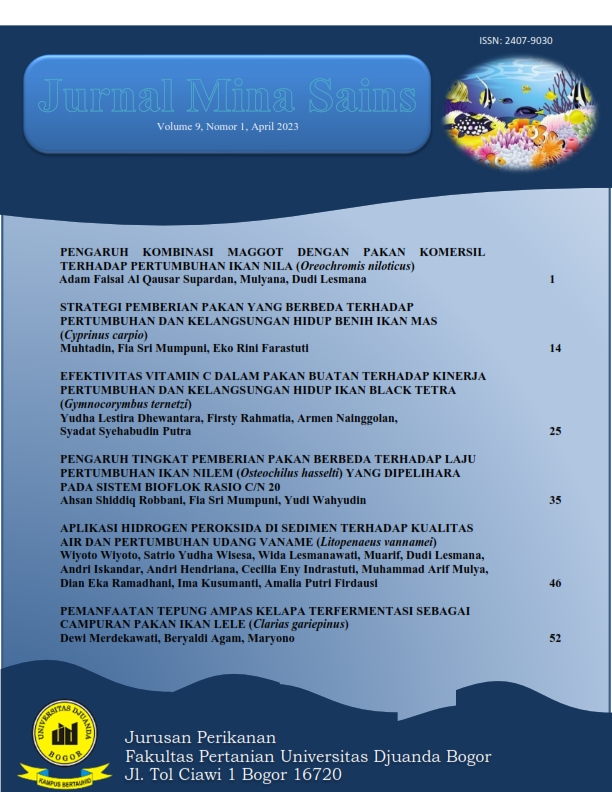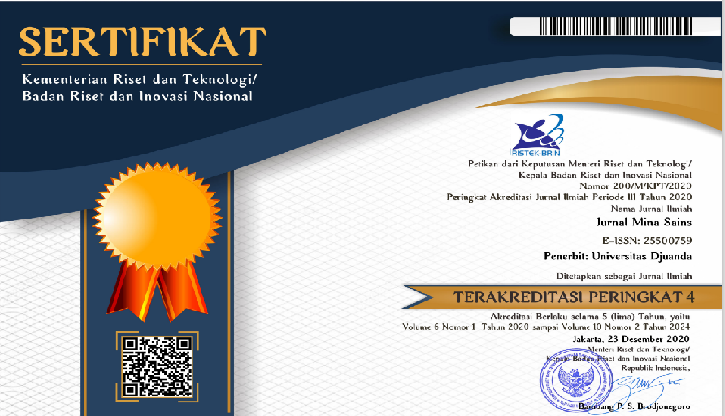APLIKASI HIDROGEN PEROKSIDA DI SEDIMEN TERHADAP KUALITAS AIR DAN PERTUMBUHAN UDANG VANAME Litopenaeus vannamei
DOI:
https://doi.org/10.30997/jmss.v9i1.8138Keywords:
kualitas air, pertumbuhan udang, sedimenAbstract
Pond bottom sediment conditions influence shrimp culture. As benthic organisms, shrimp are mainly on the surface of the pond bottom, so cultivation preparations related to improving sediment quality are essential. Pond bottom practice, such as drying, liming, and fertilizing, is common. However, in bottom pond conditions where total drying cannot be carried out, other treatments are needed, such as the addition of hydrogen peroxide. The purpose of this study was to determine the effect of adding hydrogen peroxide in pond sediments on the performance of shrimp growth and water quality. The study was conducted with five doses of hydrogen peroxide (0.25 mL, 0.5 mL, 1 mL, 2 mL) mixed with 350 g of pond soil sediment. Ten shrimps with an average weight of 0,27±0,03 g were put into the rearing container, which had been given pond bottom sediment according to the treatment. The results showed that the 2 mL hydrogen peroxide treatment gave the best results on the growth rate and average weight of Pacific whiteleg shrimp at the end of rearing. Water quality such as pH value, dissolved oxygen, and temperature were not significantly different between treatments. Hydrogen peroxide treatment can improve shrimp growth performance without affecting water quality during rearing.
References
Astria Q, Oktaviana A, Prastiti LA, et al. Penggunaan Hidrogen Peroksida dan Ion Silver (Smart Care) untuk Menurunkan Populasi Vibrio sp.
Bechmann RK, Arnberg M, Gomiero A, et al. 2019. Gill damage and delayed mortality of Northern shrimp (Pandalus borealis) after short time exposure to anti-parasitic veterinary medicine containing hydrogen peroxide. Ecotoxicol Environ Saf 180:473–482.
Boyd C, Zimmermann S .2010. Grow-out systems-water quality and soil management. Freshwater prawns: Biology and farming 239–255
Cardona E, Saulnier D, Lorgeoux B, et al. 2015. Rearing effect of biofloc on antioxidant and antimicrobial transcriptional response in Litopenaeus stylirostris shrimp facing an experimental sub-lethal hydrogen peroxide stress. Fish Shellfish Immunol 45:933–939.
Diana JS, Szyper JP, Batterson TR, et al. 2017. Water quality in ponds. Dynamics of pond aquaculture 53–71
Ebeling JM, Timmons MB, Bisogni JJ. 2006. Engineering analysis of the stoichiometry of photoautotrophic, autotrophic, and heterotrophic removal of ammonia–nitrogen in aquaculture systems. Aquaculture 257:346–358
Hasibuan S, Syafriadiman S, Aryani N, et al. 2023 The age and quality of pond bottom soil affect water quality and production of Pangasius hypophthalmus in the tropical environment. Aquac Fish 8:296–304
Hou D, Zhou R, Zeng S, et al. 2021. Stochastic processes shape the bacterial community assembly in shrimp cultural pond sediments. Appl Microbiol Biotechnol 105:5013–5022.
Ma’in M, Anggoro S, Sasongko SB. 2013. Kajian dampak lingkungan penerapan teknologi bioflok pada kegiatan budidaya udang vaname dengan metode life cycle assessment. Jurnal Ilmu Lingkungan 11:110–119.
Mustafa AA, Asaad AIJ, Linthin D. 2021. PERFORMA BUDIDAYA UDANG WINDU (Penaeus monodon) PADA MUSIM KEMARAU DI TAMBAK KECAMATAN MARUSU KABUPATEN MAROS. Media Akuakultur 16:45–56.
Nindarwi DD, Sari LA, Wulansari PD, et al. 2020. Use of hydrogen peroxide to improve potential redox land preparation of land towards increasing production of traditional shrimp vanname (Litopeaneus vanname) in Wringin Putih, Muncar, Banyuwangi. In: IOP Conference Series: Earth and Environmental Science. IOP Publishing, p 012014
Pankaj K, Jetani KL, Yusuzai SI, et al. 2012. Effect of sediment and water quality parameters on the productivity of coastal shrimp farm. Advances in Applied Science Research 3:2033–2041
Prihadi TH, Pantjara B. 2019 PENERAPAN REMEDIASI PADA SISTEM BUDIDAYA UDANG DI TAMBAK TANAH SULFAT MASAM (Studi Kasus di Kabupaten Berau, Kalimantan Timur). Media Akuakultur 14:55–62
Sahrijanna A, Pantjara B. 2016. STUDI PERBAIKAN PEMATANG TERHADAP KUALITAS AIR DAN PRODUKSI UDANG VANAME (Litopenaeus vannamei) SEMI INTENSIF PADA TAMBAK ALUVIAL DI KABUPATEN BARRU. In: Prosiding FORUM INOVASI TEKNOLOGI AKUAKULTUR. pp 215–222
Torun F, Hostins B, Teske J, et al. 2020. Nitrate amendment to control sulphide accumulation in shrimp ponds. Aquaculture 521:735010
Usio N, Imada M, Nakagawa M, et al. 2013. Effects of pond draining on biodiversity and water quality of farm ponds. Conservation Biology 27:1429–1438
Wiyoto W, Sukenda S, Harris E, et al. 2021. Pacific whiteleg shrimp (Litopenaeus vannamei) behaviour, oxygen consumption and sediment oxygen demand at different sediment redox potential. Aquaculture, Aquarium, Conservation & Legislation 14:3510–3516
Wiyoto W, Sukenda S, Harris E, et al. 2017. The effects of sediment redox potential and stocking density on Pacific white shrimp Litopenaeus vannamei production performance and white spot syndrome virus resistance. Aquac Res 48:2741–2751
Wiyoto W, Sukenda S, Harris E, et al (2016) Water quality and sediment profile in shrimp culture with different sediment redox potential and stocking densities under laboratory condition. Ilmu Kelautan
Downloads
Published
How to Cite
Issue
Section
License
Copyright (c) 2023 JURNAL MINA SAINS

This work is licensed under a Creative Commons Attribution-ShareAlike 4.0 International License.
With the receipt of the article by the Jurnal Mina Sains Universitas Djuanda Editorial Board and the decision to be published, then the copyright regarding the article will be diverted to Jurnal Mina Sains Universitas Djuanda.
Department of Fisheries Djuanda University holds the copyright regarding all the published articles in this journal.
Department of Fisheries Faculty of Agriculture, Universitas Djuanda has the right to multiply and distribute the article. Thanks to the Fisheries Department and Agriculture Faculty Universitas Djuanda that funded this journal sustainability.
The manuscript's authentic and copyright statement submission can be downloaded on this form.








